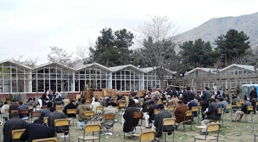
| Education System in Afghanistan |
Two education systems exist in parallel in Afghanistan. Religious education is the responsibility of clerics at mosques, while the government provides free academic education at state schools. From age 7 to age 13 pupils attend primary schools where they learn the basics of reading, writing, arithmetic and their national culture.
Three years of middle school follow where academic-style education continues. Students must pass an examination at the end of this phase if they wish to study further.
Afghanistan continues to attempt to surface from a civil war and an ultra-orthodox regime. The rights of women and a broader curriculum are both gradually being reinstated, as the nation shrugs off its past and attempts to kick-start its economy.
 Efforts are underway to recover the situation at Afghanistan’s 6 universities and to repair damage caused by civil conflict. Some progress is being made with female admissions too, although it may take many years for tertiary education to become academically independent.
Efforts are underway to recover the situation at Afghanistan’s 6 universities and to repair damage caused by civil conflict. Some progress is being made with female admissions too, although it may take many years for tertiary education to become academically independent.
The oldest of these institutions are the Kabul Medical University established in 1923, and Kabul University founded in 1931. The latter is pictured here as students write examinations sitting on chairs outside.